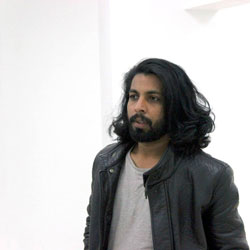2017 Karachi Biennale Artists
Muhammad Ali
Born in 1988 in Karachi (Pakistan)
Lives and works in Karachi (Pakistan)
Muhammad Ali is a multidisciplinary visual artist who graduated in 2010 from the Indus Valley School of Art and Architecture. Ali has exhibited in Pakistan and abroad with several solo and multi-person shows to his credit. He exhibited at the Bruckenthal Museum of Contemporary Art in Romania and made it as a finalist in the Sovereign Asian Art Prize and was subsequently shown in Hong Kong and South Korea. He was part of a seminal show of Pakistani artists in Dubai’s leading Lawrie Shabibi Gallery. He has recently shown in the US as well. Muhammad Ali thinks of himself as an artist of the senses who likes to manipulate, coax, create and render whole metaphysical and literal worlds of fantasy. By profession, he is a creator, an inventor and an artist, but more importantly it is his skill with emotion and what he calls his “desire radar" that allows him to flesh out ideas and engage in a meaningful dialogue.
For KB17, Muhamnmad Ali has created an installation involving the repeated image of twin elephants on the stage of the auditorium of Jamshed Memorial Hall. He writes of this work, and his accompanying performance: “The theatre and its twin dichotomies of tragedy and comedy, which encompass all the elements of human emotion as well as layers of personas which constitute our ‘realities’ is a significant inspiration. All the polarities of emotion such as compulsion and revulsion, alienation and acceptance, dreams and waking fantasies, are addressed in a manner that evokes mythological archetypes, presented as re-tellings in a critical manner.” The artist has also conceived of a separate performance for KB17, which will, in the words of the artist, “revolve around the ideas of cleanliness, purity and impurity, obsession and catharsis.”
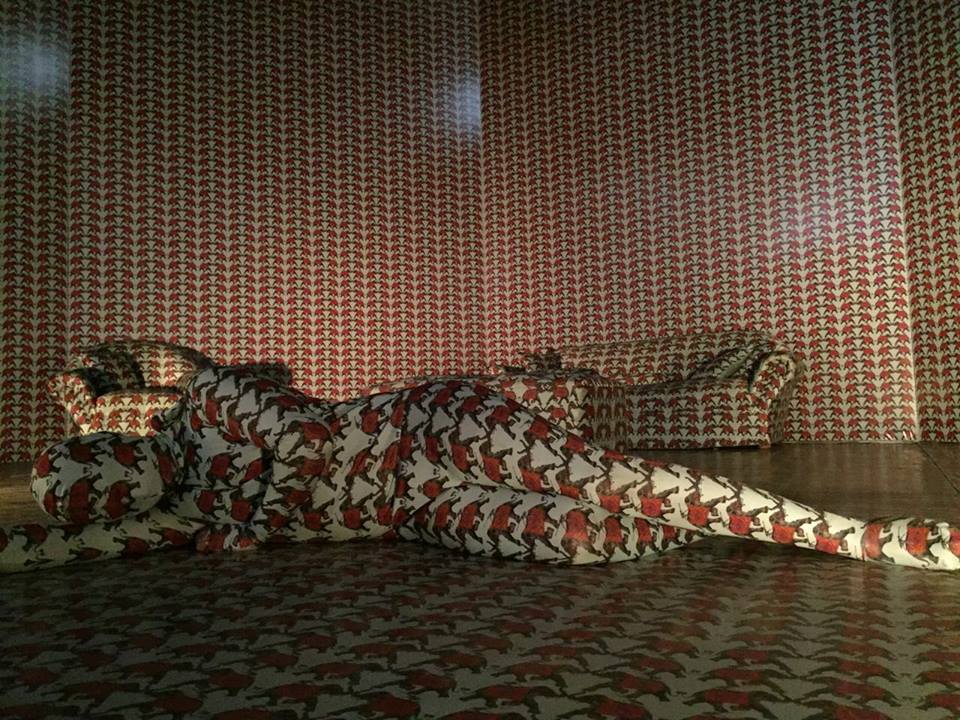
Mom! There's An Elephant In My Room, 2017.
Stickers, paint, furniture, fabric
Dimensions variable.
Performance: 3 hours.
Muhammad Arslan Farooqi
Born in 1992 in Faisalabad (Pakistan)
Lives and works in Lahore (Pakistan)
Muhammad Arslan Farooqi is a Lahore-based artist, illustrator and animator. He obtained his BFA (with Distinction) from the National College of Arts, Lahore, in 2016. His works have been featured at several group exhibitions nationally, at venues including: Gandhara Art Space, Karachi; Canvas Gallery, Karachi; Sanat Gallery, Karachi; IVS Gallery, Karachi; Studio Seven, Karachi; Zahoor ul Ikhlaq Gallery, Lahore; and at the Karachi Literary Festival, 2016. His art practice aims to amalgamate art, illustration and animation, breathing life into previously fixed and static media.
Farooqui’s series of works for the Karachi Biennale 2017 translates Mughal miniature paintings into a series of digital animations, and one accompanying, life-size sculpture. The artist’s intention was to identify the tone and trajectory of action in each of these artworks, which depict moments suspended for eternity, and then reanimate them in an aesthetic style reminiscent of the Italian ‘Commedia dell’arte’ puppetry. In doing so, Farooqi has heightened the emotional response of the viewer to the actions of the work, almost as if the viewer has been transported to the time in which these works created, reimagining the elevated impact that each miniature painting would have had on its contemporaneous audience.

Still from Dying Inayat, 2016.
Video animation
Courtesy the artist
Muhammad Zeeshan
Born in 1980 in Mirpurkhas (Pakistan)
Livers and works in Karachi (Pakistan)
Muhammad Zeeshan started working from a very young age as a cinema board painter in his hometown of Mirpurkhas in Sindh province. In 2000, he gained admission to the the National College of Arts, Lahore, where he graduated in 2003 with a Bachelor’s degree in Miniature painting. He has exhibited widely both in Pakistan and abroad. His work is in the collection of the Metropolitan Museum of Art, New York, among other institutions.
Muhammad Zeeshan writes of his submission for KB17: “It’s the worst fear of all. The seed of acute despair. But for me, ‘Failure’ has always been a great vision. It has allowed me to grow and gain motivation to resolve the challenge of the unfinished, the unsolved, the mysterious. This project is based on a selection of rejection letters sent to me by various organizations.”

Sincerely Yours, 2017.
Reflective sticker on cloth encased in acrylic sheet.
Eight works 120 x 91 cm each
Courtesy the artist
Munawar Ali Syed
Born in 1975 in Hyderabad (Pakistan)
Lives and works in Karachi (Pakistan)
Munawar Ali Syed is a multi-disciplinary artist specialising in three-dimensional mixed media, as well as performance and public art. He studied Fine Art at the National College of Arts, Lahore, obtained an MA in Fine Art from Beaconhouse National University, Lahore, and currently teaches at the Indus Valley School of Art and Architecture in Karachi. An active member of the Vasl Artist Collective, he has participated in multiple residencies and workshops, including: the Burragorang International Artists’ Workshop, Australia; the Vasl International Artists Workshop, Pakistan; the Braziers International Artist Workshop, England; and the Westbury Farm Residency, England. Along with exhibiting in several exhibitions both nationally and internationally, Munawar has had seven solo exhibitions. Recently, Munawar has taken on a new direction in his trajectory, this artistic change of tack fueled by his enthusiasm for public art. Accordingly, he has now curated four exhibitions which very much relied on heavy public participation, and has coordinated two public art projects, one reimagining Karachi’s city walls, and the other the ‘Great Wall of Truck Art’ at Islamabad Airport. His work has a self-reflective, existential flavor to it, addressing the issues one faces in an age of deception; a response to the proliferation of mass media, propaganda, and society’s general self-absorption and duality.
His installation for the Karachi Biennale 2017, Where Lies My Soul, visually emulates his artistic process of self-reflection, and acts as a witness to his artistic journey and art practice, both of which have been shaped by Munawar’s response to living in the urbanity of Karachi. By combining all the available sculptural pieces in his studio with books, drawings, carvings, framed art works, easels, and other pieces of general studio equipment, and wrapping this monolithic structure in a black sheet of plastic, he constructs his own artistic narrative that occupies the space somewhere between form, function and non-function, between the tangible and intangible, creating an ambiguity for the viewer which forces them to imagine what is wrapped inside. As an artist who specialises in three-dimensional mixed-media, Munawar’s Where Lies My Soul is a commentary on the nature of artistic production in relationship to imagery and imagination, art and non-art, among other dualities that are inherent in the artist’s multi-disciplinary concept and process. As Munawar states, “This block of wrapped objects is simultaneously an arrival and departure from my art practice.”
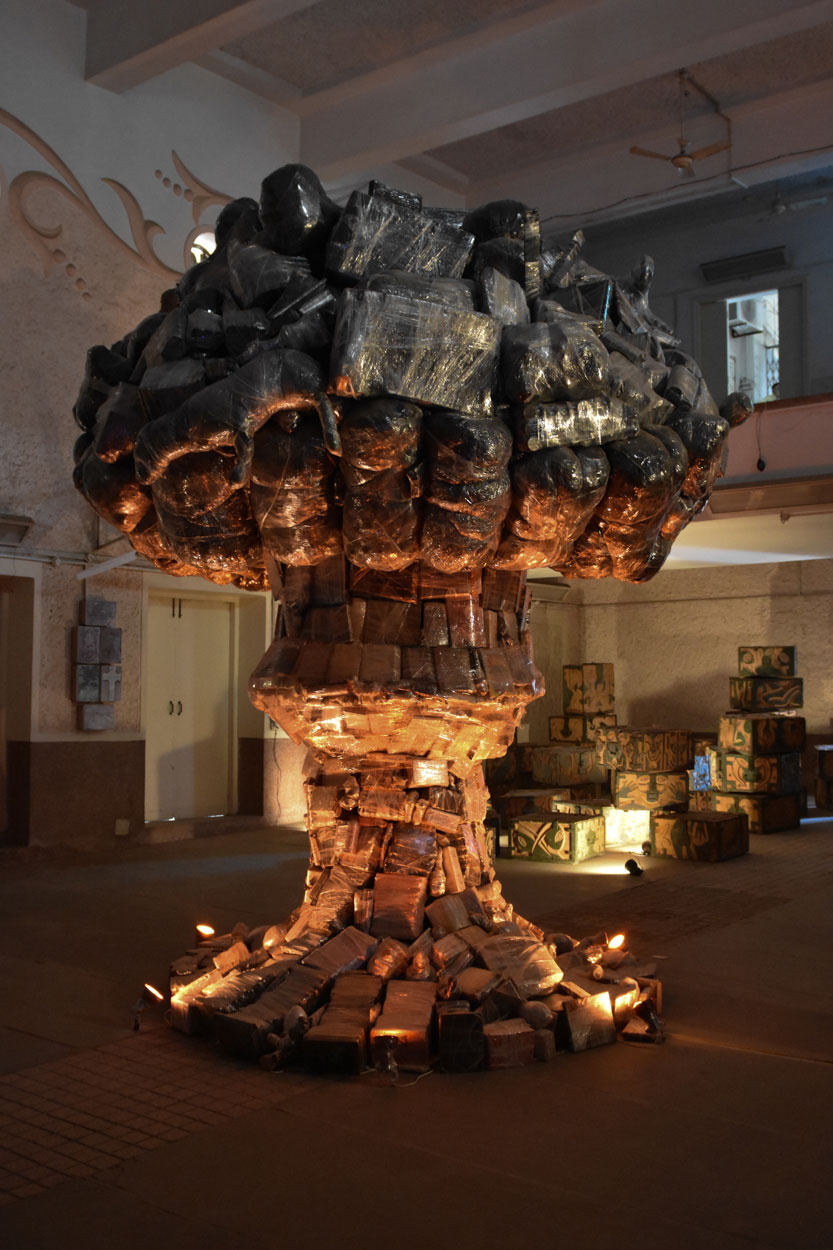
Where Lies My Soul, 2017.
Mixed media installation
240 x 240 x 240 cm.
Muzzumil Ruheel
Born in 1985 in Lahore (Pakistan)
Lives and works in Karachi (Pakistan)
Muzzumil Ruheel graduated in 2009 as a visual artist from the Beacon House National University, Lahore. His work has been shown at Lawrie Shabibi Gallery, Dubai, UAE; Wip Konshtall, Stockholm, Sweden; “Still Exotic,” Collaborative Project, Cairo Documenta, Egypt; “Space Invader,” Aicon Gallery, London, UK; Grey Noise, Bastakiya Art Fair, Dubai, UAE; “Through Other Eyes,” Aberystwyth Arts Centre, Herbert Art Gallery, Coventry and The Glynn Vivian Gallery, Swansea, Wales, UK; “Parallel Lines,” Cartwright Hall, Bradford City Art Gallery and Museum, UK; “Media as Medium,” UDK, Berlin, Germany and elsewhere. His work is part of several national and international collections.
Muzzumil Ruheel has created a work for KB17 involving a blackboard and text. He writes: “‘History Class’ is a compilation of extracts of my interactions as I fictionally live through history and its literature. I live somewhere within the history I read and I witness those documented events through my stories as a writer. I place myself within the different chapters of the past and I get to interact with all the major characters through the ages, back and forth, irrespective of a timeline. I live their truths, their realities and I realize the lies and contradictions through my fiction. Every account presented by history has multitudes of perspectives and what one sees or remembers is that which has been given importance and documentation while a lot of the small details are overlooked. My narrative is about that undocumented time, the stories and images before and after those documented narratives. One session in a history classroom has so much more to tell; there are so many stories and so many perspectives missing. If one were to try to justify this theory, there wouldn’t be enough time and space; the incessant flow of information would blacken pages, text over text over text, resembling a blackboard. The ambiguity in meaning is complemented by the darkness of ink and the text that hides in plain view and shines unexpectedly. The piece also includes the blackboard’s shadow made from shredded paper on the floor.”
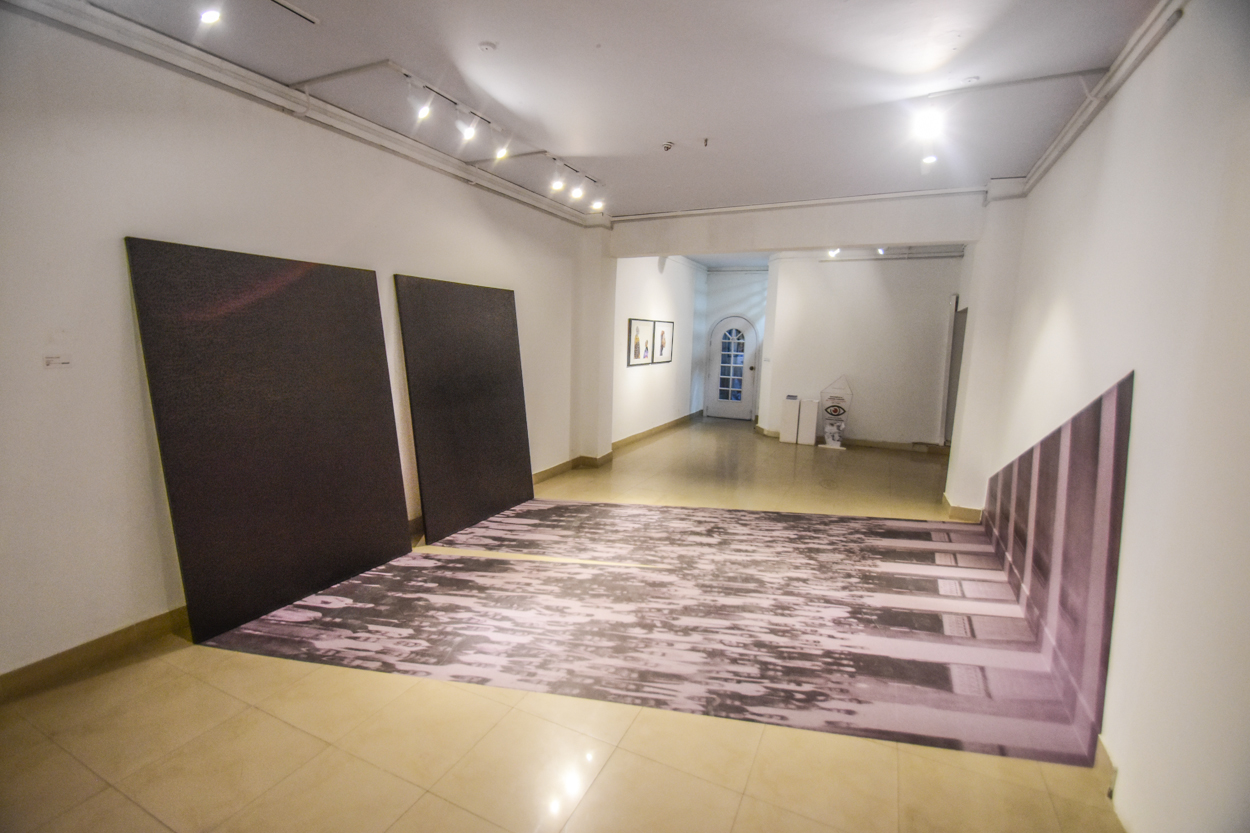
History Class, 2016-17.
Acrylics and ink on canvas and shredded paper
467 x 243 cm.
Courtesy the artist
Nadia Batool Hussain with Fatima Hussain
Fatima Hussain (b. 1983, Lahore) is an Artist-Curator/Theatre Practitioner based in Islamabad who teaches at the National College of Arts, Rawalpindi & Lahore campus. Fatima has presented projects at the Shanakht Festival Karachi; Flux Deptford X, SPILL Festival 2011 (London); Zahoorul Akhlaq Gallery, Lahore; Aicon Gallery London; The Guild NY; SAVAC, University of Toronto, and many others. Her work over the last few years has addressed multiple issues bringing into it the political, the historical, the everyday, and whether with intention or escape, ‘art’ for her, has fallen within a larger interpretation of the colonized structures, languages and territory. Fatima is a 2005 graduate of NCA (Lahore campus) where she was trained as a painter. She moved on to Central Saint Martins, UAL for her MA in Fine Arts (2007- 2008). Nadia Batool Hussain (b. 1978, Karachi) is a visual artist and art educator living and working in Islamabad/Rawalpindi. Her work is usually focused on the experience of the body, which she uses to identify the world around her. She collaborates with other artists and is focused on facilitating art practice in her community. She is currently teaching painting at the National College of Art, Rawalpindi Campus where she heads the Department of Fine Arts. Her work is an attempt to understand issues of identity and femininity in her experience. It usually focuses on narratives representing her experiences. The images and text tend to sway from the purely clinical and anatomical to something more emotional. She believes she can draw parallels between these two opposing notions by using one to identify the other.
For KB17 Nadia Batool Hussain and Fatima Hussain have collaborated on a site-specific installation entitled Correspondence. The artists write: “In response to ‘wit-ness’, the correspondence of the structure of Narayan Jagannath Vidyala High School works as the witness to the event, which in this case is the development of its surroundings. Our project takes the building as an entity that we imagine has corresponded across geographic terrains with other structures. We see this correspondence in today’s time as a witness to many events and developments even such that it finds difficult to articulate. Translation and interpretation of this correspondence (although fictive) unearths a sequence of events that reference the larger sociopolitical narrative of the region. These documents are layered with footnotes and musings of a discoverer who navigates through the letters in order to make sense of how the structure has witnessed its surroundings over time.”

Correspondence, 2017.
Installation
Dimensions variable
Courtesy the artists
Nadia Kaabi-Linke
Born in 1978 in Tunis (Tunisia)
Lives and works in Berlin (Germany)
Nadia Kaabi-Linke was born Tunis, Tunisia and raised in Tunisia and the United Arab Emirates. She graduated from the University of Fine Arts, Tunis, in 1999, and earned a Ph.D. at Université Paris-Sorbonne, in 2008. Growing up between Tunis, Kiev, and Dubai, and now residing in Berlin, Kaabi-Linke has a personal history of migration across cultures and borders that has greatly influenced her work. Her works give physical presence to that which tends to remain invisible, be it people, structures, or the geopolitical forces that shape them. Using a variety of materials and methods, Kaabi-Linke often works in-situ on projects that relate directly to their exhibition sites. Kaabi-Linke has had solo exhibitions at Centro de Arte Moderna José de Azevedo Perdigão, Fundação Calouste Gulbenkian, Lisbon (2014); The Mosaic Rooms, London (2014); and Dallas Contemporary, Texas (2015). Her work has been included in group exhibitions at KW Institute for Contemporary Art, Berlin (2011); Herbert F. Johnson Museum of Art, Cornell University, Ithaca, New York (2012); Musée National de Carthage, Tunisia (2012); Centrum Sztuki Współczesnej Zamek Ujazdowski, Zamek Ujazdowski, Warsaw (2013); Nam June Paik Art Center, Seoul (2013); Museum of Modern Art, New York (2013); Louisiana Museum of Modern Art, Humlebæk, Denmark (2014), and Marta Herford, Museum für Kunst, Design und Architektur, Herford, Germany (2016); Solomon R. Guggenheim Museum, New York (2016). She also participated in the Sharjah Biennial, United Arab Emirates (2009); Alexandria Biennial for Mediterranean Countries (2009); Venice Biennale (2011); Liverpool Biennial (2012), and Kochi-Muziris Biennial, Kerala, India (2012).
Border crossings of many kinds—European and North African, Islamic and Christian, East and West Berlin—have often served as the impetus for Kaabi-Linke’s endeavors. In No (2012), on view at KB17, she reflects on the absurd difficulties of her own application as a Tunisian for entry into the United Kingdom in order to deliver a lecture, with a pair of disembodied lips reciting the accusatory questions found on British visa application forms as a crowd of churchgoers opposes the voice of authority in unison. Also on view at KB17 is a performance work entitled “Healing,” done in collaboration with Karachi-based artist Samina Islam. The work involves stitching, text, jasmine flowers, and their perpetual upkeep.

No, 2012
2 channel video installation, 4:19 min.
Commissioned by the Liverpool Biennial 2012
Co-produced by the Kamel Lazaar Fundation
Courtesy the artist and Lawrie Shabibi Gallery, Dubai
Nahid Raza
Born in 1948 in Delhi (India)
Lives and works in Karachi (Pakistan)
Nahid Raza hails from a family with distinguished art connections. Her late father, Syed Yusuf Raza, was a journalist, art writer and the author of a book on economics. Her life in art began in 1966 when her uncle Ali Imam helped her to join the Central Institute. Later, in 1968 she held her first group exhibition while she was still a student. In 1969, she won her first award, the ‘Best Entry Award’ at the Karachi Arts Council. She was deeply inspired by the intricate stone carvings of Sindh which resulted in her first major landmark works on the Chawkandi Tombs. Soon, the mounting appreciation of her work abroad led to solo exhibitions in Japan, Bangladesh and India. On her return to Karachi, in 1987, she began teaching art full-time. In 1992, Nahid established Studio Art in Karachi, and for over a decade, nurtured several promising talents. She was awarded a residency at the New York State University in 1998. In 2002, her work was displayed in a solo exhibition at the Vienna Museum. Nahid has visited several countries across the globe for her solo and group exhibitions. These include Bezirk Museum, Vienna; Asian Art Biennial, Bangladesh; SAARC exhibition in New Delhi, and a group show called "Intelligent Rebellion" by Pakistani women artists in Bradford, England. In August 2007, Nahid was awarded the President’s Pride of Performance Award, the highest art honor in the country.
For KB17, Nahid Raza has created a major painting from her ongoing Virdh series. The word “virdh” refers to repetition of a certain incantation – a practice that exists in many religions. Nahid’s recent work revolves around motifs that have been repeatedly screen-printed on large canvases. Nahid believes there are spiritual ways to purge inner frustrations and to shed agony. One such way is the practice of Sufism, which inculcates divine ethics through devotion towards the Almighty. As a strong believer in divine realities, she has emphasized that there is spirituality in every person. She expresses the feelings that virdh creates in her soul through painting. It is her intention to depict serenity and peace in her canvases.

Virdh Series, 2017 (Detail)
Acrylic on canvas
640 x 457 cm.
Courtesy the artist
Nausheen Saeed
Born in 1968 in Lahore (Pakistan)
Lives and works in Lahore (Pakistan)
Nausheen Saeed obtained her BFA in Sculpture at the National College of Arts, Lahore before acquiring her MFA in Site Specific Sculpture from Wimbledon School of Art, London. She currently works as an Associate Professor at the National College of Arts, Lahore teaching sculpture in the Department of Fine Arts. Her work has been exhibited extensively both nationally and internationally, as well as having been shown in five solo exhibitions at galleries in Pakistan, such as: Rohats 2, Lahore; and Canvas Gallery, Karachi. Her work is part of a number of private and public collections, including: World Bank, Washington; Levi’s Pakistan, Lahore; National College of Arts, Lahore; Toyota Tsusho, Tokyo. Saeed’s feminist art practice sculpturally takes the body as the site of contention, conflict and controversy. Her work celebrates the female body, extricating her figures from the residue of the male gaze so that they exist as independent entities, proclaiming their individuality as their strength.
In her sculptural installation for the Karachi Biennale 2017, Saeed simultaneously explores the prevalence of violence in our society by using technology as an analogous visual metaphor. The dialogue created by her pair of sculptures, two identical female figures placed in separate cubicles of mirrors, one taking a ‘selfie’, the other holding a handgun to her head, represents a cutting critique of the contemporary commonplace, assimilating the pervasiveness of smartphones to that of guns, the ubiquity of ‘selfies’ to that of violence. The complexity of the statement made by Saeed’s work goes beyond the ostensible simplicity of its visual analogy; it excoriates both component parts – the gun and the smartphone, the process of taking a ‘selfie’ and shooting a gun. The latent insinuation of the work suggests that by our narcissistic obsession with online self-presentation, we are collectively partaking in a form of violence against our individual selves.
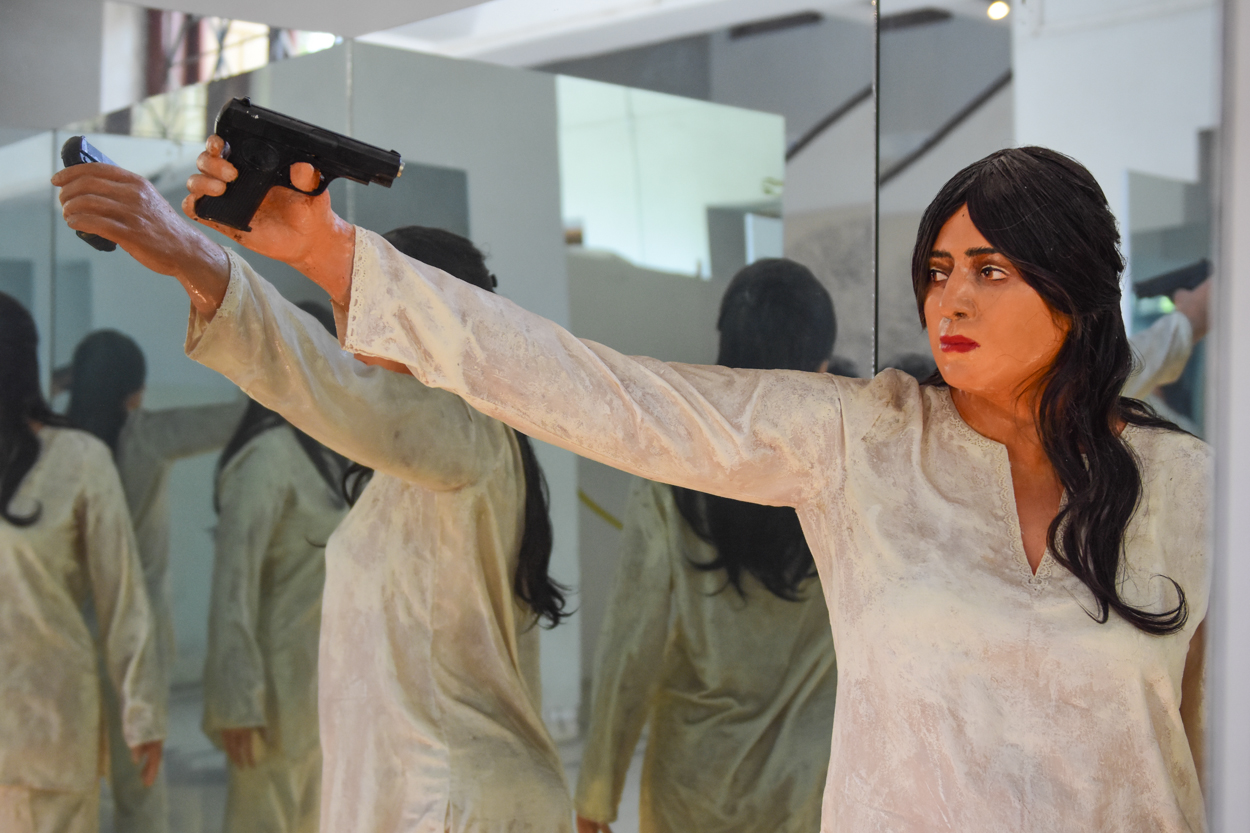
Let Me Take a Selfie, 2017.
Mixed media
175 x 95 x 82 cm. each
Nayan Kulkarni
Born in 1969 in Norwich (UK)
Lives and works in London (UK)
Trained in sculpture at Birmingham and then The Slade Schools of Art (1993 & 1997) Nayan Kulkarni is currently a PhD candidate at the Royal College of Art (Naktam: Speculative Cinematic Movement). His research is developing new ways to understand the complex formations of experience and meaning generated by artificial light in the city. The perceptual, intellectual, ethical and technological dimensions of light as medium and idea are fundamental elements in his research. Nayan is interested in the effects and affects of cinematic imagining on human experience, personal identity and the built environment. This interest is expressed in light, sound, video and performance-based works in galleries and the public realm. Recent works include; Maroon (2017, Leicester), Blade (2017, Hull City of Culture), Hryre (2012, Chester) and Mirrie Dancers 2012 (Shetland). He is currently installing a major permanent urban light installation, The Golden Hour, across Hull city centre.
Of his work for KB17, Nayan Kulkarni writes: “Combining elements of location and studio- based recordings Nayan will be making a new work for the Biennial. Exploring the nocturnal urban mise-en-scene as a site of reverie and surveillance, the work will explore the City as ill mannered, its atmospheres contingent upon themes that overlay each other in voices that collide. These constructed atmospheres are an emergent phenomena experienced in momentary equilibriums within a dynamic whole. There is no fixed arrangement that could be inferred to be a composition. Illuminating space is to rend darkness, to tear it apart, shred and fragment it, distribute it, differentiate and articulate it. Every lamp produces a radiant micro-politics of space, an organisation and articulation of its local value. Where there is no light, there is no use, no value. Lamps together project an image of politics onto space and in turn produce spaces for preferred activities. Furthermore, it makes them visible, it brings them into the tattered black. Where there was no use the rend can produce. In the cut space is rendered, made into an image of activity, that is also a space for activity: A twin channel work for a twin site production.”

Ricochet, 2017.
Twin channel video for two flat screens
Courtesy the artist
Nida Ramzan
Born in 1988 in Faisalabad (Pakistan)
Lives and works in Faisalabad (Pakistan)
Nida Ramzan received her BFA from Faisalabad G.C. University (Institute of Art and Design, Faisalabad Institute of Textile and Fashion Design) in 2010, subsequently obtaining her MFA from the National College of Arts, Lahore, in 2014. Her work has been exhibited in several group shows nationally, as well as in Venice. She currently teaches at the National Textile University, Faisalabad. Her art practice, manifesting itself both in video and on canvas, focuses on the female body and its multifaceted relationship with everyday objects in various spaces and environments. Ramzan explains the basis of her practice: “On a daily basis, I find myself overwhelmingly confronted with images and societal prescriptions of what it means, as a woman, to be ‘beautiful’. I have decided to address the illusions and realities that exist for women faced with this aspect of contemporary culture.”
In her video work on view at the Karachi Biennale 2017, Ramzan has experimented with the division of the filmed material, so that the elements, once whole, undergo a transformation, merging the natural form of the body with the other compositional objects and elements to create a shifting, two-dimensional sculpture. The work explores the pervasive contemporary issue of the premium placed on the appearance of women, visually symbolizing the resultant obsession with expending energy into self-presentation and re-creation. Playing on Ramzan’s own experience with textiles, the male figure measuring and re-measuring the female form offers an artistic critique of the psychological, corporeal and cultural implications fostered by the contemporary human condition.

Measurements, 2013.
Video, 2:11 min.
Courtesy the artist
Noman Siddiqui
Born in 1980 in Karachi (Pakistan)
Lives and works in Karachi (Pakistan)
Noman Siddiqui graduated from the Central Institute of Art and Craft, Karachi in 2005. He is a multidisciplinary artist whose work has been exhibited in various group shows, including “Microcosm” at Gandhara-Art Space, Karachi; “Movement” at ArtChowk, Karachi; “Attaining Heights” at VM Art Gallery, Karachi; “Usman aur Mein” at KOEL Gallery, Karachi; “Memoirs of the Future” at Alhamra Art Gallery, Lahore; “Pursukoon Karachi” at Arts Council Karachi; “Mad in Karachi 3D II” at ArtChowk, Karachi; and “Aghaz-e-safer” at Frere Hall, Karachi. He also curated the show “Unwriting Thoughts” at IVS Gallery, Karachi, in 2016, and attended the Fourth Sanat Residency Program, Karachi in 2017.
For KB17 Noman Siddiqui has created an installation comprised of flowers and fiberglass bullets. He writes: “Keeping in mind this city and events, I have created an installation that consists of two mounds: one of flowers and the other of bullets. These objects are opposite in nature and yet linked when seen with the eyes of a witness. The flowers shall wilt and die like the flowers left on graves by loved ones, while the bullets shall remain untarnished, much like the permanent feeling of absence caused by death.”

Mounds, 2017.
Fiberglass, industrial paint, rose petals
Dimensions variable
Courtesy the artist
Noorjehan Bilgrami
Born in 1950 in Hyderabad (India)
Lives and works in Karachi (Pakistan)
Noorjehan Bilgrami is a visual artist, textile designer, researcher and educationist. Her atelier, KOEL, pioneered the revival of hand-block printed, handloom and natural dyed fabrics in Pakistan. The KOEL Gallery, established in 2009, has provided a vibrant platform for emerging and established artists. Founder member of the Indus Valley School of Art and Architecture, she was its first Executive Director, 1990–95, and former Chairperson, Board of Governors. Noorjehan’s publication, Sindh jo Ajrak, and film, Sun, Fire, River, Ajrak - Cloth from the Soil of Sindh, document the traditional textile. She authored Craft Traditions of Pakistan and Born of Fire, a profile of Pakistan’s renowned ceramist Salahuddin Mian; a documentary film, Yeh Kiya? and curated a Retrospective Exhibition on the artist at the Indus Valley School of Art and Architecture. She was awarded the Japan Foundation Fellowship to pursue research on natural indigo in Japan and curated the exhibition ‘Tana Bana: The Woven Soul of Pakistan’ in collaboration with Jonathan Mark Kenoyer at the University of Wisconsin, Madison; the exhibition travelled to the Pacific Northwest College of Art, Portland, Oregon; the Pacific Asia Museum, Pasadena, California and Mingeikan, the Japan Folk Craft Museum, Tokyo. She spearheaded “Pursukoon Karachi,” a concept for the revitalization of the city, working with a team of over 300 artists, designers and creative persons. Noorjehan’s vision is reflected in her art practice and over the years her work has been showcased by leading galleries around the world.
Noorjehan Bigrami writes of her installation for KB17: “My art practice is informed by four decades of apprenticeship with master craftsmen of Sindh. I have previously rendered, in book form and as documentary, the traditional art of ajrak making. This labour-intensive and mysterious process continues to inspire—and it serves as the basis for my current installation piece, Witness Creation Unfolding. Traditional ajrak making is a sacred knowledge, handed down through centuries within local family ateliers. The process begins with a tearing of the kora, or unbleached cotton, and in repeated rhythmic cycles this fabric is steamed, beaten on stone, washed and wrung out, spread under the desert sun—its lengths softening, made supple and ready to receive. At each successive stage of its development, the craftsman draws upon indigenous materials. And, both in its physical sense and in its philosophy, ajrak making mirrors the path of spiritual practice in Sindh. In its final impression, a jewel-like hue emits from the textile—a deep ruby and indigo—not imposed upon, but a part and substance of its very fibre. The bearing of this process forms the core of my installation. Matiari-based artisan, Muhammed Shafique, will develop the base materials, and I will work on them from within my resources as an artist, in my studio. The collaboration culminates as a spread of panels, each pair 13 feet in height, suspended across an open light-filtered space. The project serves as personal homage to a dying textile form. In the same gesture, we are witness to the mounting journey from emptiness or kora, towards essence.”

Witness Creation Unfolding, 2017.
Mixed media installation
370 x 234 x 1270 cm
Courtesy the artist
Omer Wasim
Born in 1988 in Karachi (Pakistan)
Lives and works in Karachi (Pakistan)
Omer Wasim earned his BFA in Interdisciplinary Sculpture and an MA in Critical Studies from the Maryland Institute College of Art, Baltimore, USA. Wasim is a Lecturer in the Liberal Arts Programme at the Indus Valley School of Art and Architecture, Karachi where he teaches art history, theory and criticism. He has been practicing in Karachi since 2014, and his recent collaborative works with Saira Sheikh have been shown in Pakistan, Egypt and South Korea.
Omer Wasim writes of his installation for KB17: “My works have called upon the act of witnessing and of bearing witness to an ‘unprecedented historical occurrence of […] an event eliminating its own witness.’ These works were made to attest the presence of an absent, albeit recurring, lover, and to trace the genealogies and histories of lands lost and found. For the inaugural Karachi Biennale, the work that I am proposing will bear witness to two lovers who fall in and out of love by the Indian Ocean—with broader implications on my relationship with Karachi, family histories, and our collective relationship with the ocean and its ever shifting boundaries. The work will be made using relics of companionship, and what happens when these come in contact with the ocean. The onlooker, for example, will witness how the ocean changes the hue of fabrics, and how metal reacts when it comes in contact with saline water. I am interested in exploring the material possibilities that come with living and making work in Karachi. Karachi has been a recurring geographical point of arrival and departure in my life, both conceptually and historically—it is a place that I am bound to in perpetuity. However, my relationship with Karachi is contentious at best. Are there ways to address, disrupt, revisit, and perhaps rewrite these relationships?”
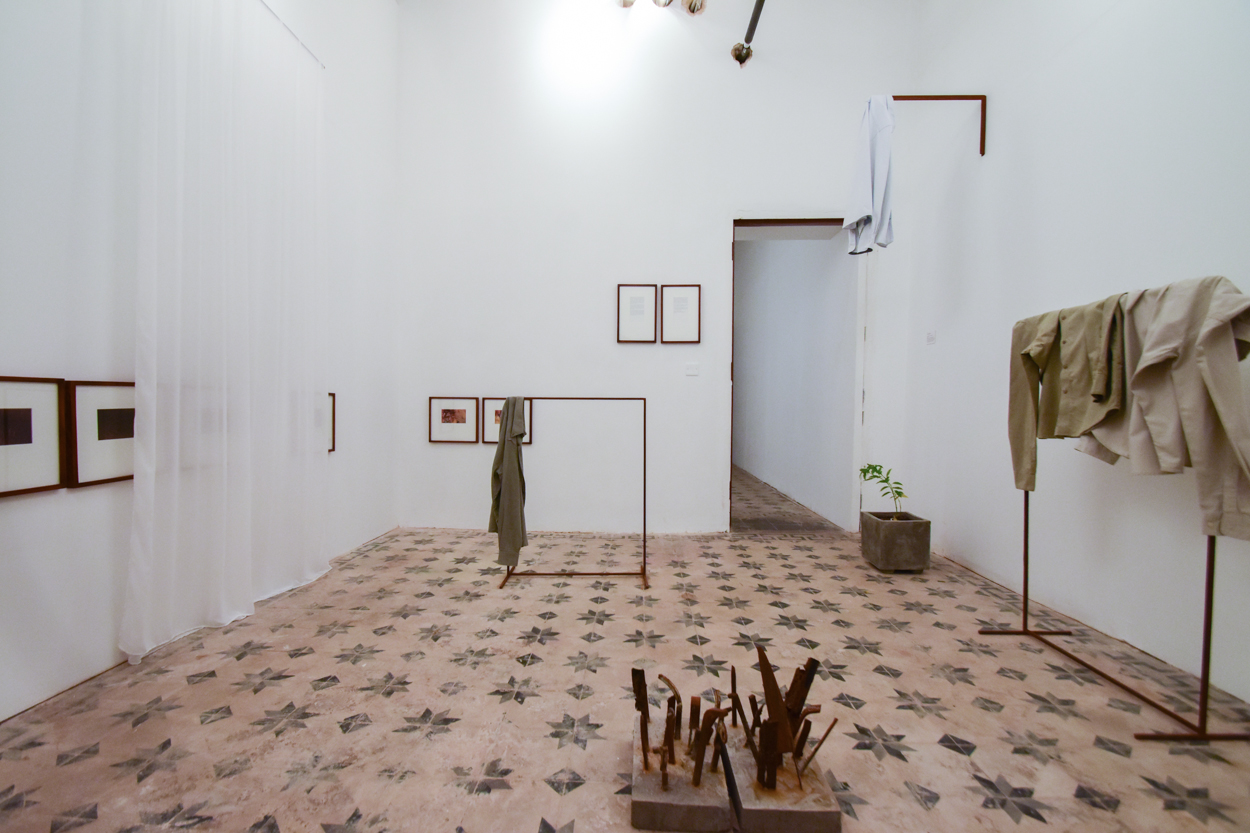
Props from an Unrealised Play, 2015-17.
Metal, shirts, concrete planter, soil, Cestrum Nocturnumm, water, pencil on paper, wood, glass, concrete, 175 pounds of nails, sea water, archival prints, fabric, glass bottles, sea salt, sand, and rust
Dimensions: variable
Omer Wasim/Saira Sheikh
Omer Wasim (b. 1988, Karachi) has a BFA in Interdisciplinary Sculpture and an MA in Critical Studies from the Maryland Institute College of Art (MICA), Baltimore, USA. He has been teaching and practicing in Pakistan, since 2014, and is currently a faculty in the Liberal Arts Programme at the Indus Valley School of Art and Architecture. Saira Sheikh (1975, Karachi – 2017, Karachi) had a BFA from the National College of Arts (NCA), Lahore, Punjab, and an EdM from Teachers College, Columbia University, New York, USA. She had been teaching and practicing in Karachi, Pakistan, since 2013, and was Associate Professor and Head of the Liberal Arts Programme at the Indus Valley School of Art and Architecture, Karachi. Omer Wasim & Saira Sheikh are visual artists who practice together, and cast a retrospective glance at the present to radically examine and mine contemporary art practices, and recent, albeit superficial, interest of the global west in their region; and also to reconfigure, re-articulate, and disrupt existing and complacent modes of artistic engagement and production. Wasim continues to execute projects that were jointly conceived.
Wasim and Sheikh have written of their practice: “Given where we are situated in time and place, unnerved by our implicit and explicit experiences and collaborating with uncertainty and volatility, we attempt to understand the present by casting a retrospective glance; treating the present as past helps defy immediacy, allowing for conceptual and critical distance from contemporary realities, both corporeal and incorporeal, systems, and rhetoric. Our aim is to debunk and unpack (self-) colonising modes of knowledge construction and circulation by embracing contradictions as central to making and thinking—since any attempt to redact contradiction compromises possibility and criticality. Using a retrospective glance, we narrate through visuals, excavated in an unspecified future, from data buried and lost in digital and material archives in and around Karachi, to reorient the gaze toward the current epoch. Our projects include fictional and factual readings of collected and constructed images and objects; in order to witness, challenge, and disrupt unitary or binary readings of human ecologies, consumption, value, and labour. The data symbolises, enacts, and enables these contradictions, intensifying the very anxieties that it aims to subjugate, and in being isolated from its context becomes a relic of neoliberalism, hinting at modes—new and old—of constructing knowledge and histories. We, as artists, are not mere participatory observers, or witnesses, but are also responsible for generating, circulating, and perpetuating these hegemonic systems of constructing knowledge and histories. Recognising that it would be fallacious to assume otherwise, we acknowledge our complicity and agency, make them an integral part of our work, while simultaneously making ourselves accountable. Stemming from these frameworks, we investigate the global contemporary, the recent, albeit superficial, interest of the global west in this region, and art practices that pander to western as well as local ideas about living and making work in, from, and about Pakistan. We work together and in lieu of depoliticising or aestheticising politics, attempt to politicise aesthetics, and radically (“from Latin radix, radic-‘root’”) reconfigure, re-articulate, and disrupt existing and complacent modes of critical engagement and artistic production.”
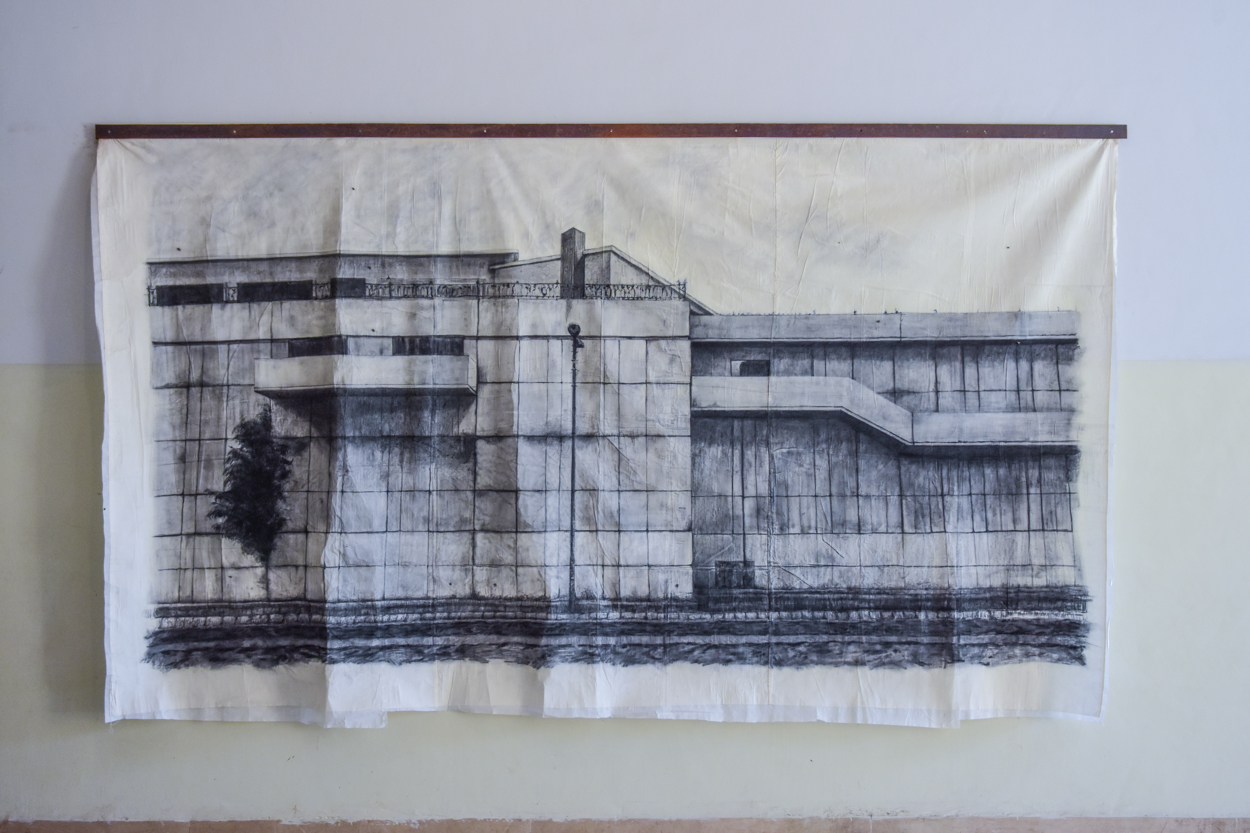
1371.2, 2016.
Charcoal and conté on reinforced canvas, with metal hanging mechanism
335 x 183 cm.
ORLAN
Born in 1947 in Saint-Étienne (France)
Lives and works in Paris (France)
ORLAN is one of the most famous French artists internationally known. She creates sculptures, photographs, performances, videos, videogames and augmented reality, using scientific and medical techniques like surgery and biogenetics. Those are only mediums for her; the idea prevails and the materiality pursues. ORLAN makes her own body the medium, the raw material, and the visual support of her work. It takes place as the “public debate.” She is a major figure of body art and of “carnal art,” as she defined it in her 1989 manifesto. Her commitment and her liberty are integral parts of her work. She defends innovative, interrogative and subversive positions in all of her artwork.
On view at KB17 are photographs from ORLAN’s African Self-Hybridatization and Precolumbian Self-Hybridization series. Shelley Rice has written of these series: “The Pre-Columbian Self-Hybridizations (1998) are in color, and mix her face with those carved on ancient sculptures, leaving her skin rough-hewn and stony. The second, African Self- Hybridizations (2000), use nineteenth-century ethnographic photographs (always in black and white) as their models, and superimpose (often extreme) African facial decorations and deformations onto ORLAN’s contemporary European visage. The Self-Hybrdization pictures are, in fact, masquerades: travels in time to distant places, cultural displacements into what Pierre Restany has called ‘a collision of times’. There is, of course, a lineage to these series: in works as diverse as Hannah Hoch's Ethnographic Museum collages from the 1920s and Wangechi Mutu’s fantastic woman-beasts of today, female artists have expressed their fractured and symbiotic relationship with the Other. ORLAN’s Self-Hybridizations are neither anthropolical nor expressive in a surrealist way. They are, instead, arenas for action and inquiry, allowing her to explore the limits of the face, of physical « branding » and expression in a global world where the boundaries of time and culture must by necessity be stretched and redrawn. An extension of her previous work, the Self-Hybridizations mark the ways in which self-presentation forges identity and relationships in an increasingly interconnected world, where people, traditions, and images are continually on the move. Contemporary art has recently caught up with ORLAN, in its dialogs about refugees, displacements, and hybrid identities.”

Défiguration-Reefiguration, Self-hybridation précolombienne n°1, 1998.
Photograph
Courtesy the artist
Pablo Lauf
Born in 1989 in Munich (Germany)
Lives and works in Berlin (Germany)
In 2016 Pablo Lauf graduated from Ostkreuz Schule, which is connected to Ostkreuz- Agentur der Fotografen, a photography agency that focuses on documentary and art photography in Berlin. Lauf has participated in several group exhibitions including: ‘AABER Art Award’ in Munich (2012); ‘Ostkreuzschule Rundgang’ in Berlin (2014-15); and ‘Perspectives From Contemporary Pakistan’ at HAU- Hebbel am Ufer in Berlin (2016). His recent work, Birds of Karachi was displayed at the Unseen photography fair in Amsterdam, in 2017. His first solo exhibition will take place at the Goethe-Institut Pakistan in December 2017.
Pablo Lauf writes of his photographs on view at KB17: “In my dreams I often find myself in strange surroundings: Empty cities, family houses, streets that seem as if they were disconnected from time. There is no one except for me, but still, those surreal rooms I explore do not seem deserted. It feels as if I slip into another layer of reality, roaming through transcendental worlds just like a ghost. One night in 2014, when I hiked in the remote mountain areas between Austria, Italy and Switzerland, I found myself in a small mountain village that made me feel as if I were dreaming awake. The sensation that overcame me while I wandered through its narrow alleys was very familiar to me. I just had never experienced something similar in my waking moments. I lost myself in a labyrinth hidden from the rest of the world by a thick, impenetrable curtain of darkness. I got carried away by the overwhelming silence of the night that was only interrupted by the buzzing noise of electricity that followed my every step. It felt as if time had stopped.”

Dissolve 01, 2014.
Black and white negative-film scan, fine art inkjet print
60 x 60 cm.
Courtesy the artist
Pala Pothupitiye
Born in 1972 in Deniyaya (Sri Lanka)
Lives and works in Mullegama (Sri Lanka)
Pala Pothupitiye obtained his degree in Fine Arts from the Visual and Performance Art University in Colombo. Raised in a village of traditional southern Sri Lankan craft-artists and ritualists, his work incorporates and reinterprets the material and philosophical content of traditional art. Pothupitiye confronts issues such as colonialism, nationalism, religious extremism and militarism, and extends his inquiry to questions of caste, the distinction between art and craft, tradition and modernity, as well as generating a critique of Euro-centrism. In 2005, he was selected to participate in the third Fukuoka Triennial at the Fukuoka Asian Art Museum in Japan, and in 2010 he won the jury award of the Sovereign Art Asian Prize, Hong Kong. At present, Pothupitiye is living and working at the Mullegama Art Center near Colombo where he runs his workshop and an art school, supporting younger artists and schoolchildren.
In his installation for the 2017 Karachi Biennale, Pothupitiye addresses the lingering detrimental effects of British colonialism on South Asia. In this work, he narrows in on two colonial legacies: tea and education. The British colonizers popularized tea both in Sri Lanka and Pakistan. The artist states, “Today tea is considered to be something soothing, refreshing. Locals and tourists alike perceive the plantations to be idyllic places. Few give much thought to the massive environmental destruction they have slowly caused over the centuries. Nor do they consider that the workers on these plantations do not benefit equally from the industry.” Similarly, the artist sees the Sri Lankan educational system as still beholden to a colonial mindset. He believes Western colonial rule institutionalized its oppressive power through its schools. In his work, contemporary tea bags are used to decorate a degree cloak with the intention of generating a focus and discussion on the negative colonial influences that still prevail in South Asia.

Colonial Dress, 2017.
Metal, clothes, threads and ropes, fiber resin, used tea bags from Pakistan and Sri Lanka, acrylic
Dimensions variable
Philippe Druillet
Born in 1944 in Toulouse (France)
Lives and works in Paris (France)
Philippe Druillet is a versatile all around artist and a pioneer in many areas (Design, Photography, Painting). Together with his friend Moebius, they broke the traditional barriers of the graphic novel. Druillet has authored many books featuring the adventures of Lone Sloane, an intergalactic adventurer who travels the universe trying to save it from Chaos. His work has been translated into English, Italian, Japanese, Dutch and Chinese. In 1998 Druillet was presented with France's highest cultural honor: Commander of the Order of Arts and Letters.
On view at KB17 are images from Philippe Druillet’s iconic graphic novel La Nuit (The Night). Druillet drew them between 1973 and 1976, during the agony of Nicole, his first wife, due to cancer. The artwork is very dark and pessimistic. It greatly influenced many European artists.

La Nuit, 1976.
Copyright Editions Glénat. All rights reserved.
Special thanks to Editions Glénat, M. Philippe Druillet, M. Jacques Glénat, and M. Benoît Cousin.
Quddus Mirza
Born in 1961 in Lahore (Pakistan)
Lives and works in Lahore (Pakistan)
Quddus Mirza is an artist, art critic and independent curator. He is the Head of Fine Arts Department at the National College of Arts Lahore, where he obtained his BFA, before acquiring MFA (Painting) from the Royal College of Art, London. Mirza has shown extensively in numerous group exhibitions, nationally and internationally, along with several solo exhibitions, held in Pakistan and the United Kingdom. He has also curated a number of exhibitions; including “Trade Union” and “Take Away’ at Zahoor ul Akhlaq Gallery, National College of Arts, and “One to One” at Alhamra Art Gallery Lahore. His other exhibitions include “Celebrating Art” and “Love” at National Art Gallery, Islamabad, “Beyond Borders: Art from Pakistan” at National Gallery of Modern Art in Mumbai, India, and “Exotic Bodies”, based on the miniature paintings from the collection of Victoria and Albert Museum, that was displayed at Preston Museum in UK. Mirza is an art critic with a regular weekly column appearing in one of Pakistan’s major newspapers, ‘The News’, and a regular column on art, Letter from Pakistan, in ‘Art India’ and in ‘Depart’ (Bangladesh) as well as contributing to other publications, such as: ‘Dawn’; ‘Herald’; ‘Himal’; ‘Libas’; ‘Contemporary’; and ‘Flash Art’. He is the co-author of the book 50 Years of Visual Arts in Pakistan and has written essays extensively on Pakistani art in different international catalogues and other publications. He is also the editor of online magazine ‘Art Now Pakistan’. Mirza applies his interdisciplinary approach to his art practice, which explores the violence, terror and fear that surrounds us, both externally and internally. His work is a byproduct of our collective fascination with violence - manifested in our domestic behavior, our attitude towards others, and in the ghoulish preponderance of reportage and footage of violence in our media. As Mirza himself states: “My work deals with these issues of our times, and place.”
In Mirza’s performative work for the Karachi Biennale 2017, entitled WIT-NESS, violence does not merely manifest itself in the subject matter, concern or imagery but in the actual process of experiencing the work, embodying the force, shock, power and pleasure usually associated with the acts of violence. The omnipresence of violence often desensitises us, as viewers, to its sanguinary reality. Hence, in his three-hour long performance, Mirza has taken away the viewers’ sense of sight by requesting them to put a strip of cloth over their eyes, before entering the gallery space, and having a sonic indication of the location of the exit. In doing so, the sensory experience of the viewer becomes the integral vehicle for the artwork, which correspondingly transcends the visual, as their physical and metaphorical blindness. To again quote Mirza: “The experience of spending a brief time inside the exhibition, without literally witnessing anything may create a sense of fear of the unknown, unusual and unexpected – elements, which for me, are essential components to elevate an object/entity into the work of art.”

WIT-NESS, 2017.
Site specific performance
120min
R.M. Naeem
Born in 1968 in Mirpurkhas (Pakistan)
Lives and works in Lahore (Pakistan)
Upon completing his BFA in 1993 as a distinction student at the National College of Arts, Lahore, R.M. Naeem subsequently held the position of Assistant Professor there. In the past twenty-two years, he has held sixteen solo shows both in Pakistan and abroad and curated various important shows of local and international artists. In addition, his work has been exhibited in numerous important group shows both nationally and internationally, including: The Asian Art Biennale, Bangladesh (2004 and 2006); The International Artists' Biennale, Iran (2006); The Pyeongtack International Art Festival Lake Museum, South Korea (2006 and 2007); Art Expo Malaysia (2010); Slick Art Fair, France (2010); AAF Affordable Art Fair, Singapore (2011); India Art Fair (2014); and Jaipur Art Summit, India (2012 and 2014). Since 1994, he has been promoting art through art education at STUDIO RM in Lahore and In 2008 he initiated the Studio RM (International) Residency program, also in Lahore.
R.M. Naeem states of his practice: “I strongly believe that by using popular social issues or political imagery in painting one cannot resolve these issues…I do not aspire to add to the chaos by portraying these circumstances in my art. What I do is a total reversal, an opposite of what is happening. My subject is that of peace, love and hope; my scenario is a world of harmony, one lost to us that we must struggle to resuscitate.” For KB17 R. M. Naeem has depicted his own children in his painting Connection. He writes: “The work is about the bonding between siblings, where this relationship challenges the norms associated with age. The older one might think that he/she is a grown-up and has a certain authority and maturity, but it is challenged by the younger one constantly…Most of the time the younger one refuses to accept the established norms and demands equality in all matters. While at the same time the love and bonding prevail.”

Connection, (Diptych) 2017.
Acrylic on canvas
189 x 229 cm.
Courtesy the artist
Rabbya Naseer
Born in 1984 in Rawalpindi (Pakistan)
Lives and works in Lahore (Pakistan)
Rabbya Naseer is a Lahore-based artist, curator, writer, critic and teacher. Her practice is broadly concerned with exploring the parallels between art and everyday life, highlighting their similarities in production, representation, reception, and interpretation. She views herself as a facilitator in the realm of cultural production, orchestrating situations of discourse and reciprocity through a variety of mediums and disciplines. With a keen interest in performative art, Naseer examines how encounters with the commonplace can spur the process of artistic creation. She obtained her Bachelor’s in Fine Arts from the National College of Arts, Lahore (2006), and was the recipient of a Fulbright scholarship for her Master’s in Art Theory and Criticism from SAIC, Chicago (2008-2010). She has participated in exhibitions, residencies and conferences in Pakistan, India, USA, UK, Dubai, China, Japan, Germany, Netherlands and Australia.
Naseer’s video work for the Karachi Biennale is part of her ongoing project that aims to develop an archive of Pakistani performance art. Her project investigates the many unique aspects and challenges imbued within the discipline of performative art; the ephemeral nature of a performance piece entails the necessity for photographic or video documentation, yet this residual evidence can never appropriately capture the experiential and sensory nature of the work for a member of the audience. Neither can this documentation fully describe the context of the performance, time and space being essential aspects in its realisation. However, without such recordings, and their compilation in an archive, the only remaining testimony of the work comes from the highly subjective perspective of the viewers, and the artist themselves, which must come in the form of mandatory ekphrasis. Naseer’s project examines the divergent, often oppositional aspects that constitute a performative piece of art. Naseer explains the thematic relevance of her project: “The Karachi Bienniale’s theme is closely aligned with the subject of my project. It’s a perfect setting to share a few works through a form that aims to explore the role of the ‘witness’ in relation to performance art.” Rabbya Naseer’s collaborative performance with Hurmat Ul Ain, Dropping Tears Together II, is also part of the Karachi biennale 2017.
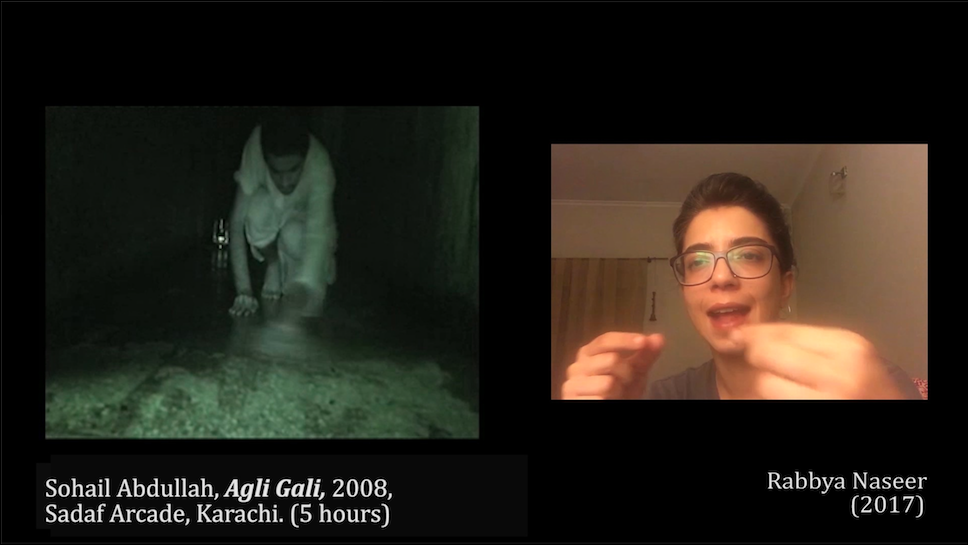
Witness, 2017.
Video, 42:31 min.
Rehan Bashir Jalwana
Born in 1982 in Dubai (UAE)
Lives and works in Lahore (Pakistan)
With degrees in Fine Arts, from the National College of Arts in Lahore and Parsons The New School For Design in New York, Rehan Bashir's initial practice was based around painting, drawing and printmaking but has now evolved into a more transdisciplinary pursuit. Under the tutelage of Nahid Siddiqui, a renowned Kathak dance exponent, Rehan has been exploring classical dance and performance and draws inspiration from Yoga and meditation. He has been teaching Yoga in Lahore since 2014. He has very recently performed at the Dakshina Dance Festival in Washington DC, USA and at the Zofin Palace in Prague, Czech Republic.
Rehan Bashir Jalwana writes of his dance recital, which is in collaboration with seasoned musician and producer Mekaal Hassan: “It's an homage to my Guru, Nahid Siddiqui. Our focus while working on this piece is quietude and silence, and how they can be conveyed through movement and sound and their relationship with space. These are concerns that have been a part of my training as a dancer and important components of the Kathak that Nahid Siddiqui has researched and developed over her career as performer and teacher. Based firmly in it's roots of tradition and my training in yoga I want to explore moments of abstraction within the piece which will be composed by the maestro Mekaal."
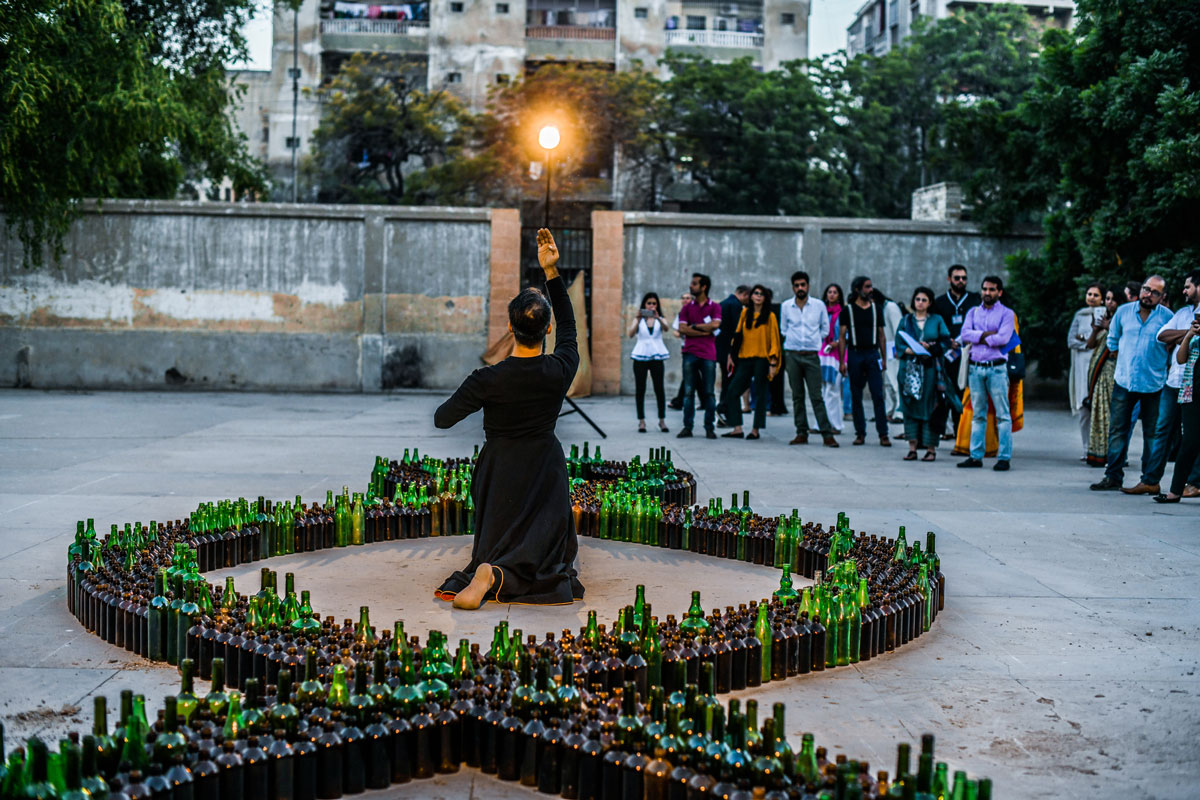
Tribute to Nahid Siddiqui, 2017.
Performance
8:00 min.
Riccardo Muratori
Born in 1981 in Rimini (Italy)
Lives and works in Venice (Italy)
Trained in Philosophy, Riccardo Muratori’s research focuses on the relationship between the “image” and reality, and on the virtualization process produced by new media and technologies operating at the present stage of advanced capitalism. He studied in Venice at Università Ca’Foscari and in Paris at Paris VIII Saint-Denis and Paris VII Jussieu where he attended a number of seminars held by such prominent figures as Alain Badiou, Jacques Morizot and Jacques Rancière. He graduated in 2006 in Philosophy from Università Ca’ Foscari under the supervision of Umberto Galimberti and Luigi Perissinotto with a dissertation based on Jean Baudrillard’s theories. In his dissertation “Games of Reality and Simulation,” Muratori began to enquire into the “status of the image,” considered - according to linguistic theory - as “signifier” of a “signified” (Saussure). From 2006 to 2009, he attended several courses of Philosophy and Aesthetics held by Giorgio Agamben at the Università IUAV - Faculty of Visual Arts - in Venice. In 2007, stimulated by the study of Phenomenology, he decided to change his research tool embracing at first drawing and then painting. In 2009 he became a teaching assistant (“Drawing” course held by Daniele Bianchi) at Università IUAV - Faculty of Fashion Design (CLADEM) - in Venice. In 2011 he was invited to exhibit his work at the 54th International Art Exhibition “La Biennale di Venezia” at the Italian Pavilion with one of his first pictorial works: The Servant, which was the starting point of a new process intended to produce a psychological theatre of simulacra. Since 2013, he has been Professor of Drawing and Illustration at Università IUAV - Department of Fashion Design, Visual Arts, Theatre in Venice.
Riccardo Muratori writes of his painting on view at KB17: “The female figure, depicted in this painting, could be interpreted as a muse (Aoede), who conceals herself or takes refuge through the instrument which should be the means of proper expression. Her generative force, momentarily suspended, is hidden by melding into her own shadow. The creation of a shield with a guitar is an expression of a phase of latency: does it represent a definitive withdrawal or rather a hiding place from which to launch a decisive attack?”

Girl with Guitar, 2015.
Oil on canvas
152 x 110 cm.
Courtesy the artist
Richard Humann
Born in 1961 in Suffern, NY (USA)
Lives and works in New York (USA)
Richard Humann is a New York City-based neo-conceptual artist. His work has been exhibited at the Kemi Art Museum, the Tampere Art Museum, the Aine Art Museum, Museo Cristóbal Gabarrón, the Macao Art Museum, the Daelim Contemporary Art Museum, the Youngeun Museum of Art, and the Kaohsiung Museum of Art, among other institutions. Much of his work is considered to be minimal, not so much in the art historical sense, but in that he strips away what he feels is not necessary to tell the story of the piece. His goal is to have the art that he creates read like poetry. He wants it to be a short distillation of a concept that touches not only the heart, but the mind as well. That is the thread that runs throughout his work, whether in drawings, sculptures, videos or installations. Language, words, dissected letters, codes and visual metaphors often become the mechanism for the dissemination of his intent.
For his installation for KB17, A Tide of Credence, Humann revisited his 2013 work, The Same River Twice, in which he took a map of the Hudson River (on the banks of which he was born and raised) from its head north of Albany, New York to its eventual flowing out past the island of Manhattan. He then transposed the shape onto a large pedestal and cut the river out from it. He gathered many of the writings that inspired him from his youth, including excepts from The Brothers Karamazov, The Sirens of Titan, Sweet Thursday, Gulliver’s Travels, as well as from poems by e.e. cummings, among other works, and then filled the shape of the river up with the words of excerpts that he had disassembled. These writings were the inspiration that led the artist to move to New York City so many years ago. As Humann states, “The river lifted me up and floated me downstream, where I began my life as an artist.” Like New York, Karachi is a city of migrants. In A Tide of Credence for KB17, he has recreated the Indus River with its tributaries that flow down through Pakistan to the Arabian Sea. He asked Pakistani immigrants living in New York to write down their hopes, dreams, and beliefs in their native Urdu. He then cut up the written text in an effort to reduce it to its purest meaning and placed it into the riverbed. He also took excerpts from poetry, history and literature, both historical and contemporary, and did the same. This collection of personal and collective accounts flows with the tide of the river, from its northern, eastern and western borders, and works its way south, towards Karachi.
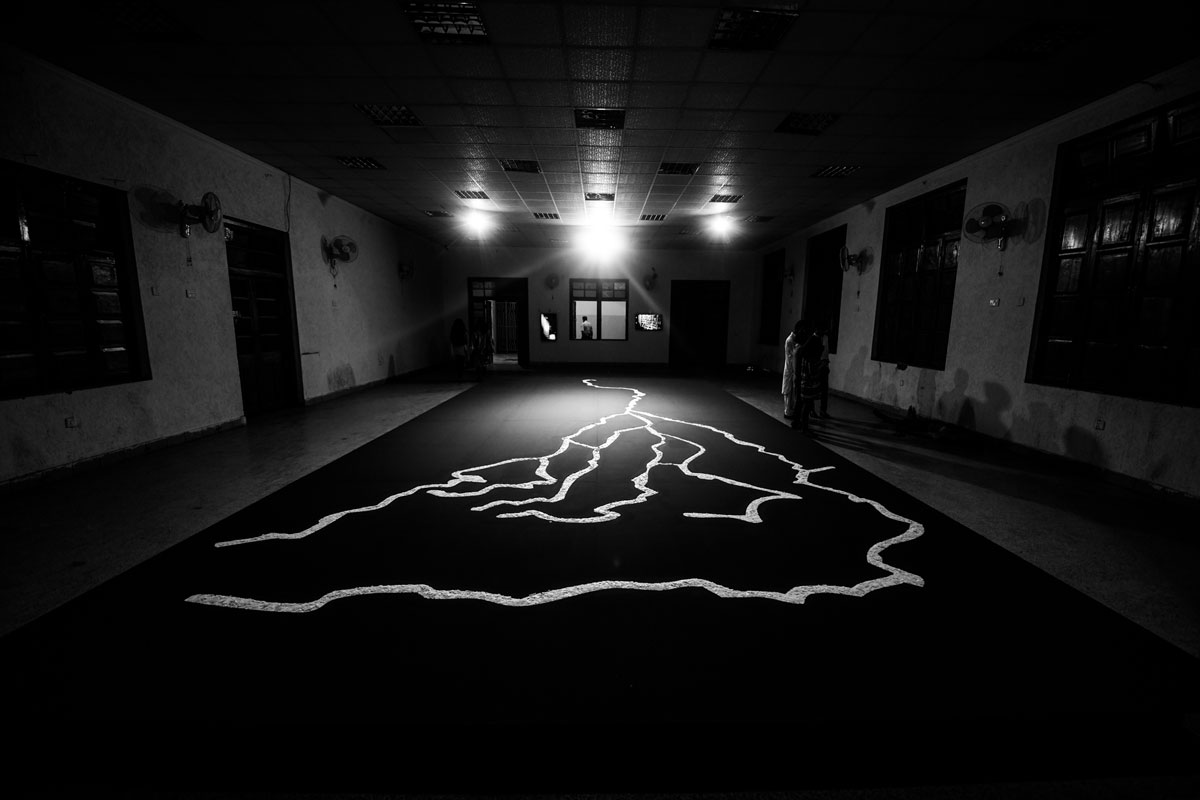
A Tide of Credence, 2017.
Wood, paper, ink
5 x 985.5 x 125 cm.
Courtesy Elga Wimmer Gallery, New York


